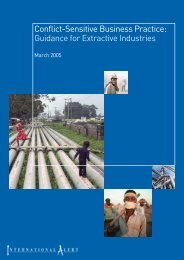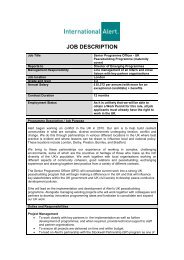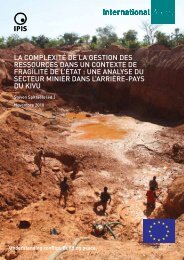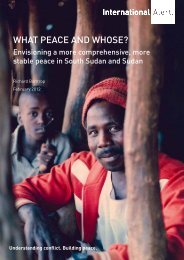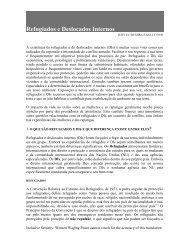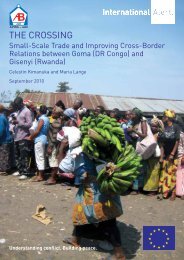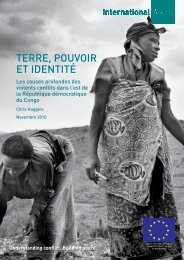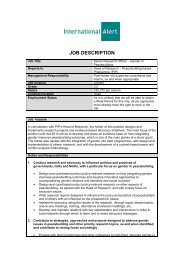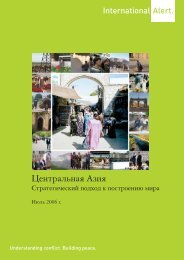Full report - International Alert
Full report - International Alert
Full report - International Alert
- No tags were found...
You also want an ePaper? Increase the reach of your titles
YUMPU automatically turns print PDFs into web optimized ePapers that Google loves.
23 • Women’s Bodies as a Battleground: Sexual Violence Against Women and Girls During the War in the Democratic Republic of CongoThe combined effects of the war that broke out in Rwanda in the early 1990s and the successive conflictsof 1996 and 1998 in Congo helped to exacerbate the already latent ethnic and inter-communal conflictsin this area. The fact that numerous Banyamulenge joined the ranks of the RPA, which was regarded bythe other ethnic groups as an army of aggression and occupation gave rise to sharp divisions among thecommunities and made the situation an explosive one. The Banyamulenge combatants were thus on theone side, while on the other the Bembe, Fulero and Vira enrolled in the Maï Maï militias. The situationbecame even more complex and volatile when alliances were formed between the Burundian FDD armedgroups, the ex-FAR and the Interahamwe militia to oppose the RCD, the Rwandan army and theBanyamulenge. At the time of the second Congolese war in 1998, splits appeared within the Banyamulengecommunity. These divisions became clearer from 2002, when one part of the Banyamulenge continuedfighting alongside the RCD and its Rwandan allies, while the other, under the command of Masunzu,allied itself with its former enemy the Maï Maï to oppose the allied RCD-RPA, which had become thecommon enemy.This conflict situation in the Moyens Plateaux was to persist almost until the ceasefire accords of 2003.It was marked by massacres of the civilian population, pillaging, forced displacement of people andwidespread rape and sexual violence against women and girls.2.5.3 Shabunda TerritoryShabunda Territory is the largest in the DRC, covering 28,000 km 2 . Situated in the great tropicalrainforest, Shabunda is relatively cut off, with its roads impassable or unsafe, so the only link with otherareas is by air. The distance between the main town of Shabunda and the provincial capital, Bukavu, is340 km.Two mutually hostile groups, the RCD and the Maï Maï indulged in a brutal war in this vast territoryafter the second Congolese war broke out in 1998. The confrontations intensified between February 1999and September 2002. The RCD eventually took military control of the larger towns, and so the only wayto get from Shabunda-Centre to Lulingu, stronghold of the Maï Maï leader Padiri, was by air.The territory’s socio-economic situation has deteriorated significantly since 1998, with disastrousconsequences for people’s health. When the RCD seized the main town of Shabunda in September 1998,aerial bombardments destroyed the town’s main hospital as well as a large number of houses. Whatremained of the hospital was subsequently looted. Before the war the territory had 66 health centres. By2001, only 34 remained operational – and these were out of stock of essential medicines. The other centreshad been either destroyed in the fighting, or else looted. At the time when this survey was carried out,66% of the children brought to these centres were suffering from severe malnutrition and 33% frommoderate malnutrition. At least 1,060 children are treated in the centres for malnutrition every year. In2003, there were only two doctors in post in the whole territory. The main causes of morbity are malaria,acute respiratory infections, malnutrition, schistosomiasis, sexually transmitted diseases and HIV/AIDS,anaemia and tuberculosis.As in many other areas, the war led to a massive exodus of the population. There has been widespreadsexual violence against women. Many women had been engaged in productive activities in the fields orthe forest at the time when they were raped, but now were just cultivating small patches of land aroundtheir homes in order to ensure their families’ survival.2.5.4 Kalehe TerritoryKalehe Territory remains extremely militarised. Numerous militias and armed groups have been fighting eachother since the first war in 1996. The Haut Plateaux area of Kalehe consists of forests which stretch fromKalehe to Masisi. Its exceptionally abundant mineral resources and very fertile soil mean that it is highlycoveted land. According to local people, Rwandan Hutu militias are the principal perpetrators of violence andabuse against them. They state that numerous Rwandan Hutus, and in particular soldiers of the ex-FARmoved into the territory after the Hutu refugee camps were closed by the Rwandan Patriotic Army in 1996.





